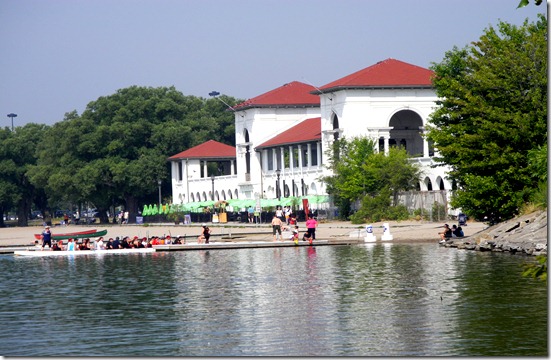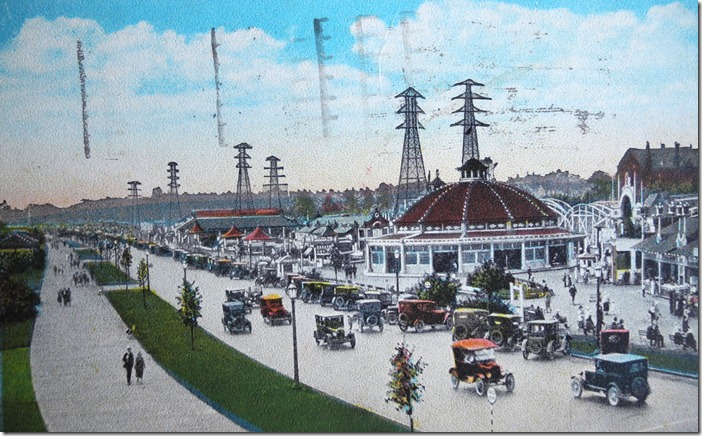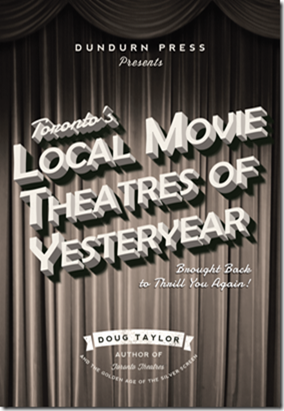The Bathing Pavilion at Sunnyside in July of 2012. The building was opened to the public in 1922.
During the dreary days of Toronto’s mid-winter, it is pleasant to recall the times I spent as a child under the hot sun at Sunnyside Beach. During the 1940s, one of the highlights of the summer was a visit by streetcar to the sandy shoreline beside Lake Ontario. In this decade, Sunnyside was the location of the city’s largest amusement park. Known as “the poor man’s Riviera,” it is a pity that it has completely disappeared from the scene.
My father arrived in Toronto as an immigrant in 1921, and the following year, glorious Sunnyside officially opened as the city’s new amusement park, adjacent to the beach that had been an attraction for generations. Prior to the opening of Sunnyside Amusement Park, the main amusement park was located on the Toronto Islands, at Hanlan’s Point, known as “Canada’s Coney Island.” It included the city’s baseball stadium, where Babe Ruth hit his first homerun. In 1926, the Maple Leaf Team relocated to the mainland, at the foot of Bathurst Street. This was necessary as fewer people were visiting Hanlan’s Point after Sunnyside opened.
The area that we know today as Sunnyside was annexed to the City of Toronto on 22 January 1888. Sunnyside stretched from Humber Bay in the west, to Roncesvalles Avenue in the east. The name Sunnyside was derived from the summer home of John G. Howard, who in 1848, built a modest structure in the area. He named it Sunnyside,” as it was on the “sunny side” of a grassy hill, a short distance north of the present-day Queensway Avenue. The structure was located between Glendale and Sunnyside Avenues. However, Howard’s main residence was further west, in High Park, and was named Colborne Lodge. On the site of Howard’s Sunnyside Villa, in 1876, the Sisters of St. Joseph’s Sacred Heart built an orphanage that they named the Sacred Heart Orphanage. Howard’s Sunnyside Villa was retained by the orphanage as an office. The villa survived until 1945, when the villa and orphanage were demolished to construct St. Joseph’s Hospital.
Sunnyside Beach
By the year 1900, Toronto had expanded westward, and the land to the north of Sunnyside was becoming increasingly populated. At Sunnyside, there was a narrow wooden boardwalk alongside the sandy beach, and on the other side of the boardwalk, the old Lake Shore Road. As the 20th century progressed, Sunnyside increasingly became a favourite place during the summer months for Torontonians to stroll the boardwalk or have a dip in the waters. One of the most popular bathing spots was at the foot of Roncesvalles Avenue.
Around the year 1910, the City of Toronto Councillors began discussing the possibility of building an amusement park at Sunnyside, at a projected cost of $19 million. It necessitated reclaiming land from the lake through landfill. The project was finally approved and the work began in 1913, but unfortunately the outbreak of the First World War interrupted the project. The landfill work commenced again in 1918, and by the time it was completed, over 1400 acres of land had been reclaimed from the lake. The landfill was derived from the dredging of the Toronto Harbour and Humber Bay.
The city’s new amusement park was opened by Mayor Mcguire on June 28, 1922. The project was not finished, but the Bathing Pavilion and Amusement Park had been completed, along with 75% of the western section of the landfill. During the next few years, over 200 more acres of land were added. To create a protected area for bathers, a short distance from shore, a 17,895 feet break wall was built, providing a hundred acres of protected waterways for swimmers. The break wall remains to this day.
The first year Sunnyside was open, thousands of people descended on the amusement park to enjoy the enlarged beach, and stroll the newly-built 20-foot wide boardwalk. Many others visited the Canoe Club. Included among the popular attractions were the concession stands, which rented beach chairs, as well as those that sold root beer, popcorn, and hotdogs. Sunnyside also possessed a drug store, a dance pavilion, guess-your-weight scales, souvenir stands, an open-air theatre named the Band Stand, a delicatessen, sight-seeing services, and a shoe-shine shop.
Originally, seven amusement rides were approved by the city, including the Whip, Aero Swing, two other low-level swings, Dodgem ride, the Frolic and a Merry-Go-Round (carousel). Nine games of chance were approved – Monkey Racer, Coney Racer, a shooting gallery, Kentucky Derby, Torpedo Race, Balloon Race, and Figure 8. There were also ten food stands, several boat rentals, and some high-powered telescopes. Sunnyside also became the site of the annual Easter Parade, where Torontonians displayed their new spring outfits as they strutted along the boardwalk.
The 1930s and 1940s were the height of Sunnyside’s popularity. Even the wealthy who owned large cottages in Muskoka paid a visit to the amusement park when they were in the city. Fireworks displays and the burning of old sailing vessels attracted crowds in the evenings. A ladies’ softball league played their games at Sunnyside, and well-known entertainers performed at the Bandstand. Beauty pageants attracted a diverse crowd. Every weekend during the summer months, families departed early in the morning to spend the day at the famous beach. The smell of popcorn, hot dogs, frying onion at the food stands, as well as the cries of the barkers for the games of chance, and the click-clack of the amusement rides, were all a part of the symphony of Sunnyside.
During the 1950s, as automobiles became more affordable, Torontonians took to the highways and Sunnyside was less attended. In 1955, the Toronto Harbour Commission ordered the demolition of Sunnyside. By the end of 1956, the demolition had been completed. For those who had enjoyed Sunnyside as a retreat from the hot humid streets of the city, a glorious era had ended. All that remained were the fond memories. The site of Sunnyside is now buried beneath the Gardiner Expressway or a part of the expanded Lakeshore Boulevard.
I am grateful to Mike Filey and his book “I Remember Sunnyside.” (published by Dundurn Group in 1996) for some of the information contained in this post.
A 1920s postcard of Sunnyside amusement park and the famous boardwalk. The view faces west toward Humber Bay. The famous boardwalk is on the left of the photo. The lake is to the left of the boardwalk, but is not visible. The large circular building with the red roof is the merry-go-round.
Crowds in 1920 on the beach in front of the Bathing Pavilion, watching a regatta. Toronto Archives, S1257, S1057, Item 090.
Sunnyside Beach and Bathing Pavilion in 1970. Photo from the City of Toronto Archives, F0124, fl0003, id 0027.
To view the Home Page for this blog: https://tayloronhistory.com/
For more information about the topics explored on this blog:
https://tayloronhistory.com/2016/03/02/tayloronhistory-comcheck-it-out/
The publication entitled, “Toronto’s Theatres and the Golden Age of the Silver Screen,” was written by the author of this blog. It explores 50 of Toronto’s old theatres and contains over 80 archival photographs of the facades, marquees and interiors of the theatres. It relates anecdotes and stories by the author and others who experienced these grand old movie houses.
To place an order for this book:
Book also available in Chapter/Indigo, the Bell Lightbox Book Shop, and by phoning University of Toronto Press, Distribution: 416-667-7791 (ISBN 978.1.62619.450.2)
Another book, published by Dundurn Press, containing 80 of Toronto’s former movie theatres will be released in June, 2016. It is entitled, “Toronto’s Movie Theatres of Yesteryear—Brought Back to Thrill You Again.” It contains over 125 archival photographs and relates interesting anecdotes about these grand old theatres and their fascinating history.
Another publication, “Toronto Then and Now,” published by Pavilion Press (London, England) explores 75 of the city’s heritage sites. This book will be released on June 1, 2016. For further information follow the link to Amazon.com here or to contact the publisher directly:
http://www.ipgbook.com/toronto–then-and-now—products-9781910904077.php?page_id=21.


![f1257_s1057_it0090[1] f1257_s1057_it0090[1]](https://tayloronhistory.com/wp-content/uploads/2013/01/f1257_s1057_it00901_thumb.jpg)
![f0124_fl0003_id0027[1] f0124_fl0003_id0027[1]](https://tayloronhistory.com/wp-content/uploads/2013/01/f0124_fl0003_id00271_thumb.jpg)
![cid_E474E4F9-11FC-42C9-AAAD-1B66D852[1] cid_E474E4F9-11FC-42C9-AAAD-1B66D852[1]](https://tayloronhistory.com/wp-content/uploads/2016/05/cid_e474e4f9-11fc-42c9-aaad-1b66d8521_thumb1.jpg)



